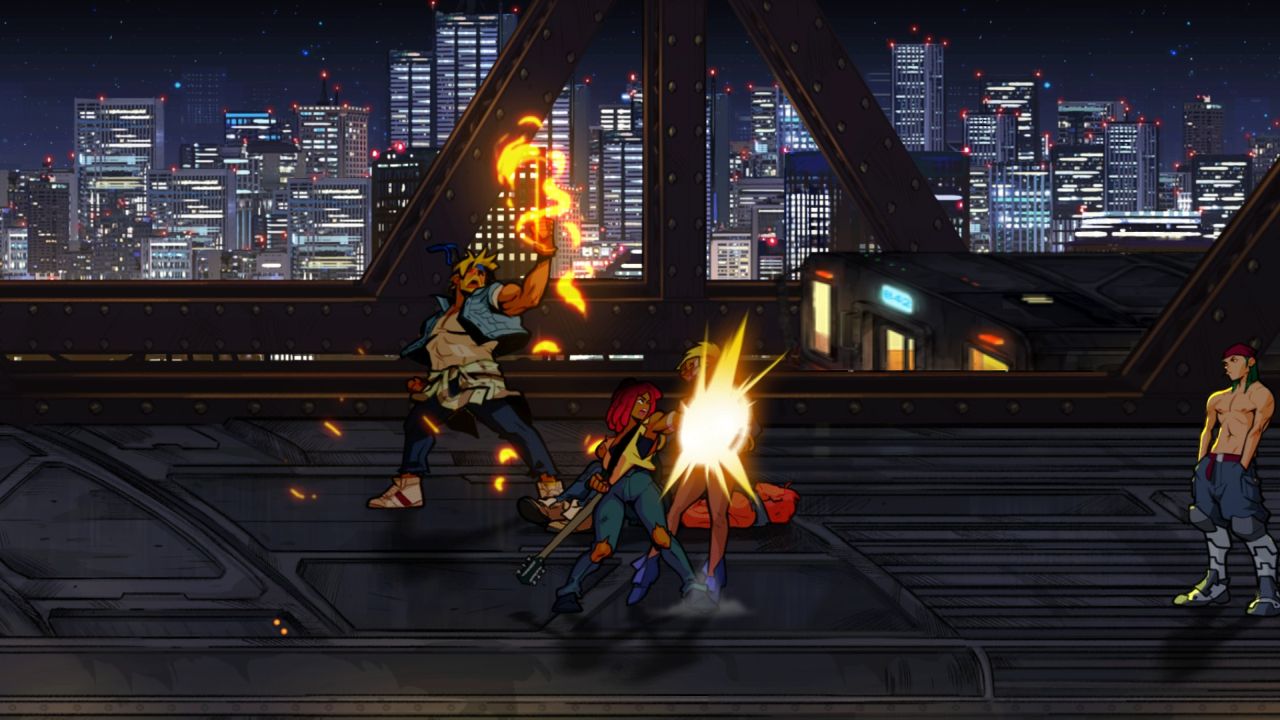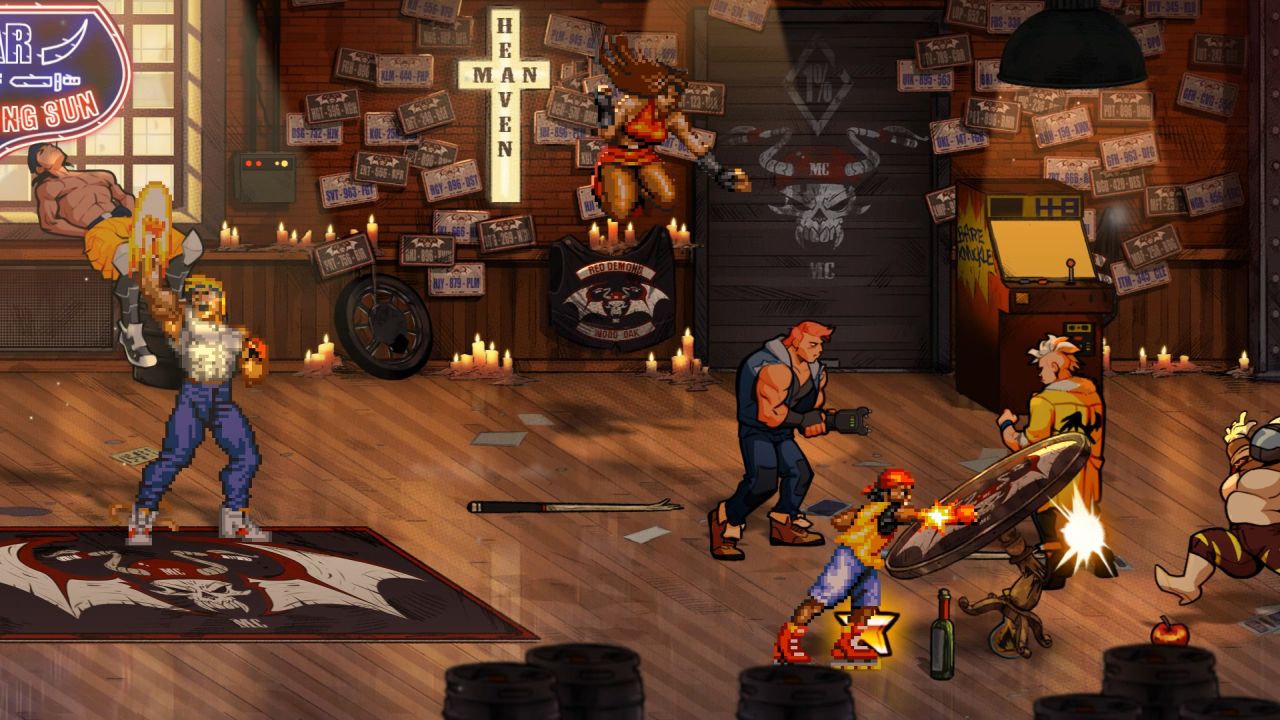Streets of Rage 4 Review
A brawler that combines nice new art with older mechanics
You'd be forgiven if you haven't heard of the Streets of Rage franchise before. This side-scrolling 2D fighting franchise saw its first three entries between 1991 and 1994 on the Sega Genesis, in an era where games like this were in abundance. Fast forward over 20 years, and for one reason or another, Dotemu, Lizardcube and Guard Crush Games have decided to bring it back. The new entry, Streets of Rage 4, imagines what it would be like if games in this genre were released today, keeping many of the gameplay pillars intact, but of course featuring modern visuals and features.

The Streets of Rage 4 campaign is comprised of 12 stages to punch your way through. The narrative in the campaign is pretty thin, as a group of vigilantes is trying to stop their Wood Oak City from being taken over by a pair of evil twins named Y. The twins are apparently children of Mr. X, the villain from the previous games. The narrative is rather brief and is not really meant to offer much context beyond the very basics. The story elements appear between stages as static screens with some subtitles, which look nice, but are minimal.
Like the arcade games of old, the idea is that players will fight their way through the campaign a few times, using multiple characters and perhaps difficulties. The stages will take you across a few different locales, from the streets, to a pier, a concert, a police precinct, and more. Each location features its own set of unique and common enemies, and culminates in a boss battle.
You choose the difficulty at the start of the campaign, and there are separate leaderboards for each. While the game classifies itself as a brawler, it turns out to be more of a proper fighting game in the sense that it's rather challenging. Even normal difficulty will be tough for some players, as you only get two lives, and failure means starting the stage over. The stages take about 10 minutes, but that time is definitely extended as you might have to try it a few times. To help, players can activate an assist which gives them extra lives, but this reduces your final score exponentially.

Streets of Rage 4 is a 2D fighting game, and in old-school fashion you can also move up and down on a 2D plane. You pick from one of 5 characters, who each have their own feel and attacks, but the controls remain the same. Floyd and Axel are two hulking fighters, while Adam is a bit more agile; Cherry and Blaze are even quicker still. Each character has their basic attack button, as well as a jump. You can also pick up and use/throw various weapons that enemies drop, such as knives, baseball bats, swords, and grenades. You can also perform strong attacks, back attacks, and throws. All of these abilities are simply tied to the same attack button with combination of your movement. So on the surface, Streets of Rage 4 tries to keep things simple.
When you're in trouble, you can use a powerful Star Move, assuming you have some stars in your possession. There's also a Special attack bound to the Y button, which lets you pull off some powerful extended combos that you'd see in more traditional fighting games. The catch, though, is that these Specials temporarily drain your health meter. To get that health back, you have to deliver some regular attacks – but if you get hit before getting it back, it's lost for good. This risk and reward system often feels too dicey to use consistently, as the game is often challenging enough as it is. The stages have a few items hidden in breakable containers, such as food that restores health, which frequently make the big difference.
While the controls are deceptively simple, Streets of Rage 4 is no cake walk. The enemies you'll face range from street thugs, to biker gangs, to police officers, and they all have unique attacks to watch out for. You grow to learn which moves each enemy has, letting you plan a bit, and learn their wind-ups. In later stages, things get interesting as enemies sometimes fight each other, or begin throwing things at you. The environment also occasionally comes into play, with wrecking balls hanging from ceiling, explosive barrels, or pools of poison. But the difficulty doesn't always come from enemy numbers or their health bars, as the AI is actually extremely basic and will just try to circle around you, occasionally going in for an attack; they often perish on their own to those same environment hazards without your intervention.

You're always outnumbered and with no ability to dodge or block, and slow movement speed, you have to be careful with each punch you throw. When there are many enemies on screen, it becomes almost impossible to dodge everything. Not only because most of your characters lack the mobility to escape to another part of the screen, but also because that you have to account for the fact that you and enemies can move up and down the 2D fighting plane. This leads to a lot of inconsistencies with which hits land, and you're never quite sure if you're clear of an incoming jumping attack. It also makes a lot of attacks impossible to dodge, as certain enemies attack you diagonally. Enemies also frequently spawn behind you, and even often begin their attack from off-screen, again adding to the annoyance. Another random design blemish is that when holding a weapon and wanting to pick up health, you're forced to throw it away as it's bound to the same button.
Another point of frustration is that many enemies, particularly bosses, do not get interrupted no matter how much you hit them, and deliver their painful blows anyway, leaving you exposed as there are limited windows to do damage. Speaking of bosses – and the campaign stages in general – there is some very noticeable uneven difficulty. Some bosses and stages are a cakewalk, even late in the campaign, while others will make you want to quit. Since there is no progression system linked to your character, this just appears to be mishaps in design and enemy composition balance.
Beyond the campaign, there are a few modes to extend the experience. You can do stage select, though you can only select the same difficulty or lower that you beat the campaign on. In Arcade mode, there is no saving and you only get one shot to finish the entire campaign; Boss Rush lets you square off against the main villains directly. No matter which mode you chose, you are earning points to level up your profile, which eventually unlocks pixelated versions of characters from the previous Streets of Rage games.

And of course, there is a variety of multiplayer options offered. You can play through the campaign and boss rush in local and online co-op, with the option to turn friendly hitting off. Playing with a friend certainly makes things much easier, and seems to be what the game was balanced for. If you're feeling competitive, you can also dive into Battle mode where you square off against another player directly. Online population is decent, large enough that you can find an opponent or co-op partner within a few minutes. There are occasional pauses and connectivity issues, but the game seems to be stable for the most part.
The art of Streets of Rage 4 is likely its standout feature. Created by the same folks who worked on the 2017's Wonder Boy: The Dragon's Trap, the visuals are crisp and clean, with the level backgrounds featuring nice attention to detail and variety. The color palette is lovely and the hand drawn esthetic really comes to life on screen. Similarly, the characters are well animated, while still keeping their retro feel and rigidness of moves. The accompanying soundtrack follows the same mantra - it's a bit on a loop like the games of old, and yet the music is catchy and well produced.
If anything, Streets of Rage 4 does exactly what it intends to. It creates a sequel to a game series not seen in 20 years - keeping the mechanics familiar enough, while adding a few new elements. This means the gameplay remains deceivingly simple, and perhaps dated. The combat in and of itself is often decently satisfying, but the high level of difficulty is off-putting, even on Normal. With barely any dodging and no blocking for the player, enemies often overwhelm and have a longer attack range. It feels like the battle is skewed against you, making for a frequently frustrating experience. Still, fans of just this sort of old-school approach should be pleased, and will enjoy the great art style and good music. With its agreeable price tag, Streets of Rage 4 won't reignite this 2D genre back to life, but it might introduce some new fans to this older school of game design.
 Comments
Comments











